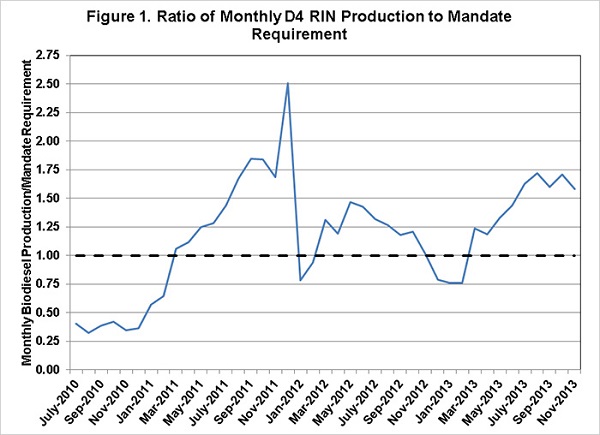The proposal by the U.S. Environmental Protection Agency to cut the amount of biodiesel to be blended into the Nation’s fuel supply could have some pretty big impact on the Renewable Identification Number (RIN) situation in the coming year. In this piece in Biodiesel Magazine, the author looks at an analysis from the University of Illinois that shows how biomass-based diesel could be affected by what’s being proposed.

“[D4 biomass-based diesel] RIN generation has exceeded implied mandate needs for 2013 since March, following a pattern similar to that experienced under similar circumstances in 2011 as blenders provided incentives to increase biodiesel production to take advantage of a potentially expiring tax credit,” Paulson writes. “Assuming a D4 RIN generation level of 260 million gallons for December, total D4 RIN generation is estimated to exceed 2.65 billion gallons (1.77 billion biodiesel gallons) in 2013.”
The EPA proposal suggests stalling the biodiesel mandate at 1.28 billion wet gallons, or 1.92 billion RIN gallons, and slashing the total advanced mandate from 3.75 to 2.2 billion gallons. Paulson says there’s potential for 806 million total advanced (D3, D4 and D5) RIN carryover into 2014, all of which are D4 biomass-based diesel RINs (equivalent to 537 million gallons of biodiesel). While the statutory and proposed limits for D4 RIN carryover into 2014 are both 384 million RIN gallons (256 million biodiesel gallons), he says statutory limits of total advanced rollover would be 750 million RIN gallons, meaning “56 million advanced RINs may be rolled into 2014 but would have to be demoted for use towards the renewable component of the mandate…”
The piece goes on to say that the EPA has ignored that RIN stock levels should remain positive to allow for the flexibility the system was intended to provide, making the carryover of RINs bump up against the 20 percent rollover limit provision.

